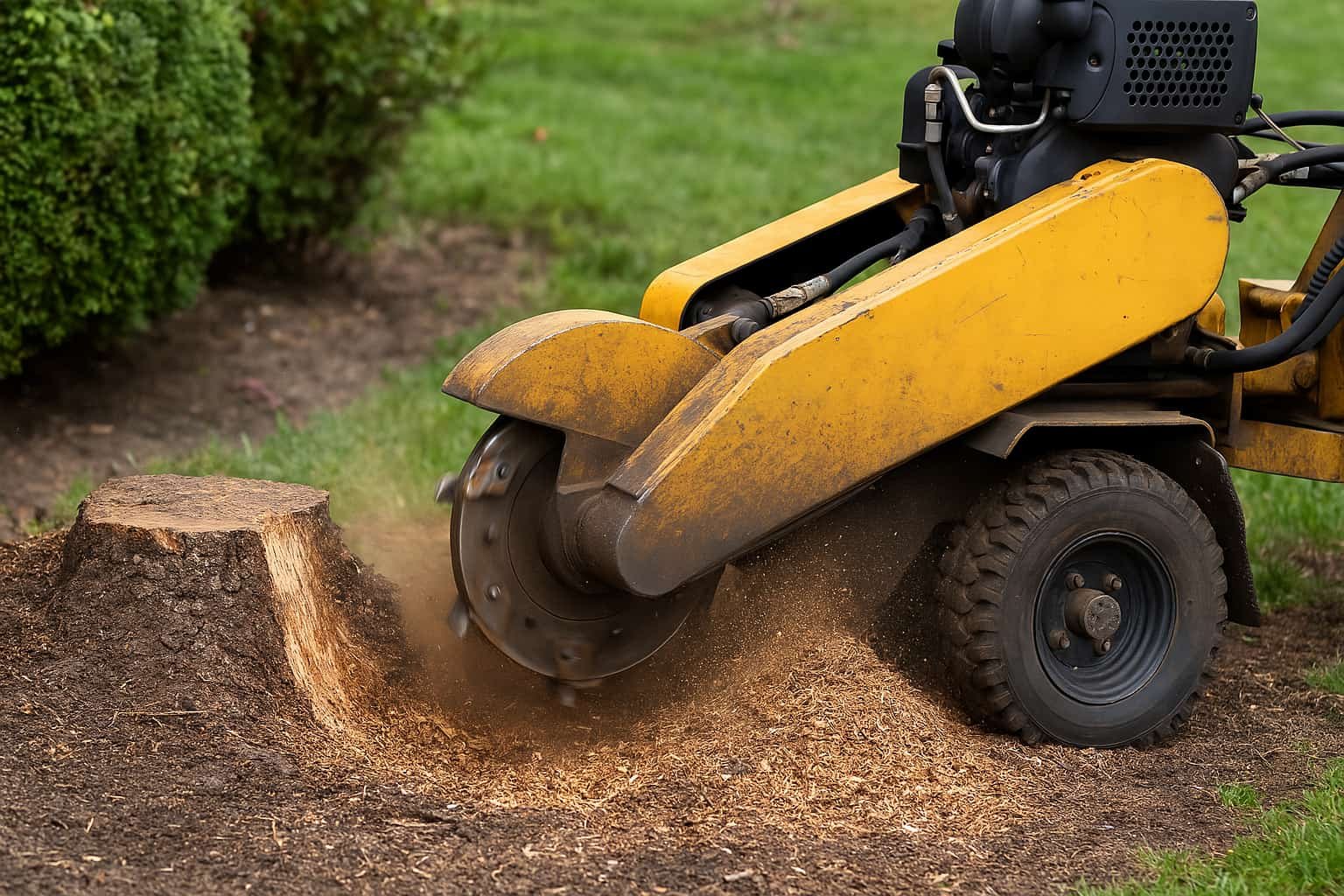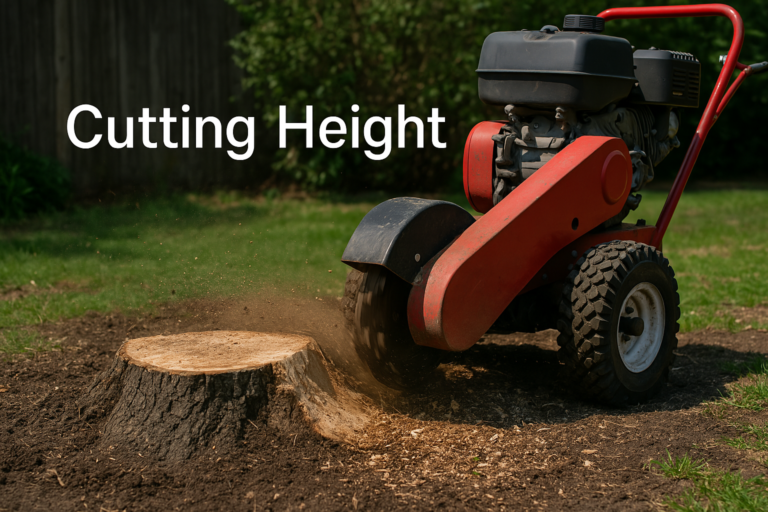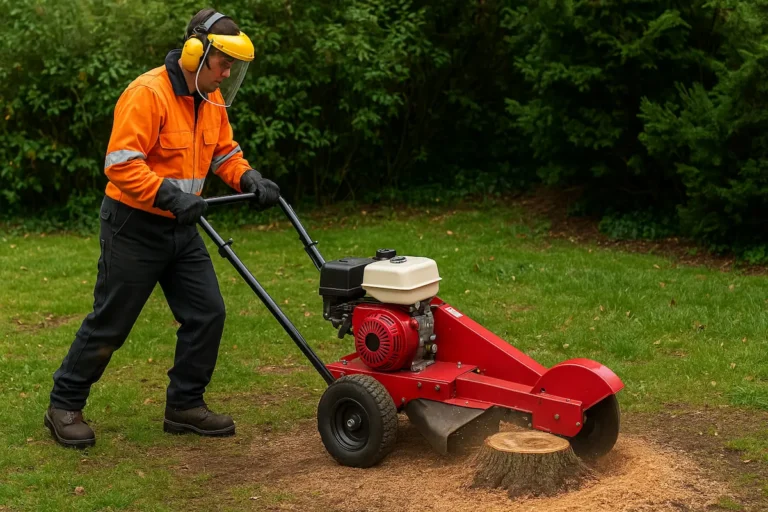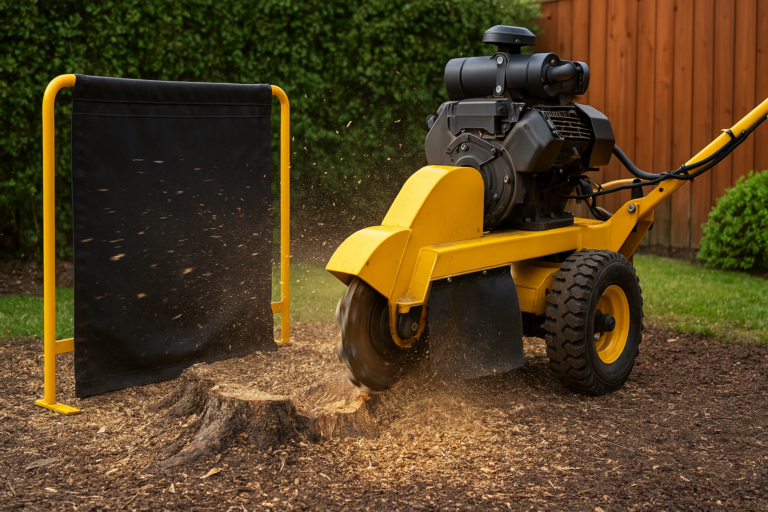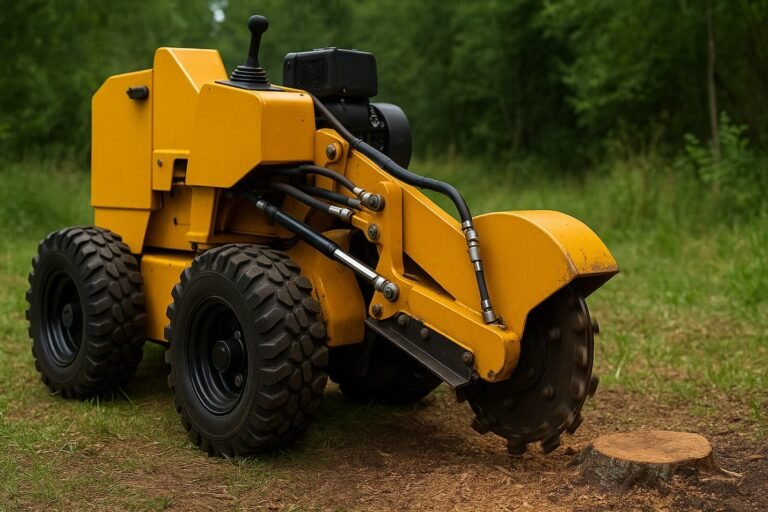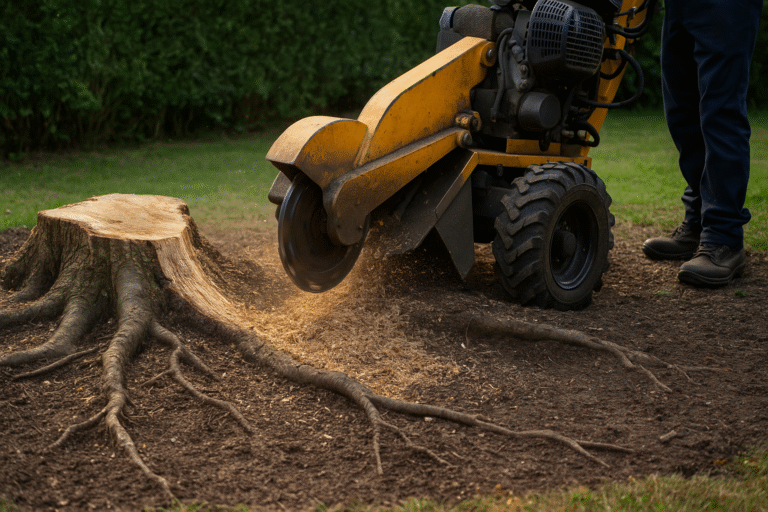Mastering Stump Grinder Depth Control: Safety and Success in the UK
Stump grinding machinery needs a lot of care.
Depth control helps you grind safely and to protect yourself and the environment around the grinder.
It stops the grinder from cutting too deep.
This guide explains how depth control works and why it matters for UK projects.
Key Takeaways: Matching Grinding Depth to Your Project
- Varying Depths: The chart shows that the necessary stump grinding depth varies significantly based on what you plan to do with the area afterwards.
- Shallowest Grinding: Tidying up or preparing for paving generally requires the shallowest depth (around 5-10 cm / 2-4 inches), just enough to remove the stump base below the surface.
- Standard for Grass: For laying new turf or seeding grass, a moderate depth of 10-15 cm (4-6 inches) is typically recommended to allow space for topsoil and root growth.
- Deeper for Planting: Planting flowers, shrubs, or especially a new tree requires considerably deeper grinding (20-30 cm / 8-12 inches for shrubs, 45 cm / 18 inches or more for trees) to remove the old root system and provide ample room for new roots.
- Efficiency & Safety: Choosing the correct depth avoids wasting time/fuel by grinding unnecessarily deep and, crucially, helps minimize the risk of hitting deeper, potentially unmarked utilities or obstructions. Always confirm project needs and perform safety checks (like utility locates) before starting.
What Exactly is Depth Control in Stump Grinding?
Depth control means deciding how far down the grinder’s cutting wheel goes.
It stops the wheel from digging too deep under the ground.
Think of it like setting a limit.
This control is super important for safety and getting the job right.
Quick Summary
- Always start shallow and check utility lines before grinding.
- Match grinding depth to your end goal (grass, plants, paving).
- Deeper grinding = more time, wear, and fuel. Only go as deep as needed.
- Manual grinders need extra care—check depth often.
Defining the “Depth Stop”: More Than Just a Button
Sometimes, a grinder has a special part called a depth stop.
This might be a physical block or a setting.
But depth control isn’t always a specific button or part.
It often means the way the person using the grinder manages the depth.
It’s about careful handling and checking how deep you are grinding.
How Operators Achieve Depth Control: Common Methods
People control stump grinder depth in a few main ways:
- Mechanical Stops: Some grinders have bolts or plates you can adjust. These physically stop the cutting wheel from going lower.
- Hydraulic Limits: Bigger, professional grinders often use hydraulics. You can set limits in the hydraulic system to control boom movement.
- Operator Skill: Many times, especially with hire machines, the user controls depth manually. They carefully move the levers and often check the depth with a ruler or shovel handle. This needs practice.
- Electronic Systems: A few very modern grinders might use sensors. These systems help manage depth very precisely, but they are less common.
Why You Absolutely Must Control Grinding Depth: The Critical Reasons
Controlling how deep you grind is not just helpful; it’s essential.
Ignoring depth control can lead to serious problems.
Safety is the biggest reason.
Safety First: Avoiding Catastrophic Utility Strikes
This is the most important reason for controlling depth.
Under the ground, hidden pipes and cables carry gas, water, electricity, and phone lines.
These utilities can be very close to the surface.
Hitting a gas line could cause an explosion or fire.
Hitting an electric cable could cause electrocution.
Hitting a water pipe leads to flooding and costly repairs.
Damaging communication lines cuts off phones or the internet.
These accidents are dangerous, expensive, and can even be fatal.
Fact: Services like “LinesearchbeforeUdig” in the UK help locate public utilities. You MUST use this service before digging or grinding.
But Markings aren’t always perfect. Private lines (like garden lighting or shed power) are sometimes not marked.
Careful depth control gives you an extra layer of safety, even after lines are marked.
Real Experience: “I always start grinding shallow, maybe just an inch below the soil, especially near marked lines. You can always grind deeper later. You can’t undo hitting a pipe!” is advice often shared on professional forums.
Meeting Your Project Goals: Achieving the Right Finish
What you plan to do with the area after grinding matters.
The correct depth depends on your plans.
- New Grass: To lay turf or plant grass seed, grind about 10-15 cm (4-6 inches) below ground level. This leaves space for soil and grassroots.
- Flowers/Shrubs: Planting flowers or small bushes often needs more depth. Aim for 20-30 cm (8-12 inches) to give roots room to grow.
- New Tree: If you plan to plant another tree, you must remove most of the old root system. This might mean grinding 45 cm (18 inches) or deeper.
- Paving/Concrete: If you’re putting down a path or patio, you might only need to grind slightly below the surface. Just enough to get the stump base out of the way.
Controlling the depth ensures the ground is ready for what comes next.
Grinding too shallow leaves annoying stump bits.
Grinding too deep makes extra work filling the hole.
Operator Insight: “The first thing I ask the customer is, ‘What are you doing here afterwards?’ That tells me exactly how deep I need to grind. No point going 12 inches deep if they’re putting grass down.” This is a common practice shared in online videos.
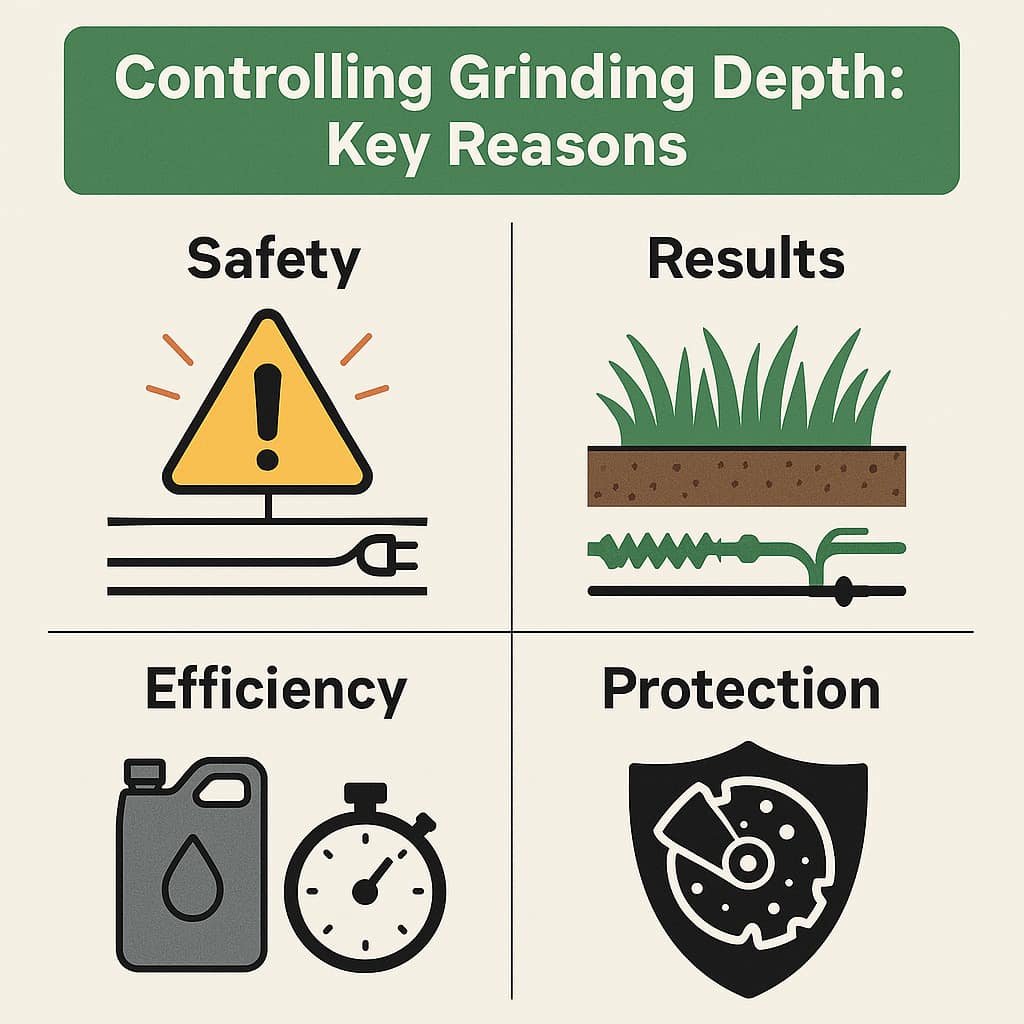
Working Smarter: Boosting Efficiency and Saving Resources
Grinding takes time and effort.
The grinder uses fuel (petrol or diesel) or electricity.
The cutting teeth wear down with use.
If you grind deeper than needed, you waste:
- Time: It takes longer to remove more material.
- Fuel: The engine works harder for longer.
- Tooth Life: Deeper grinding wears teeth faster, especially in tough soil.
Proper depth control means you only remove what’s necessary.
This makes the job faster and saves money on fuel and replacement teeth.
It’s simply a more efficient way to work.
Protecting the Equipment: Preventing Costly Damage
The soil beneath a stump can hide nasty surprises.
Large rocks, old bricks, buried concrete, or thick roots can be hidden deep down.
If the grinder wheel hits these complex objects quickly, it can cause serious damage.
- Teeth: Cutting teeth are strong but can chip, break, or shear off if they hit something solid unexpectedly. Replacing teeth is expensive.
- Wheel: A significant impact could damage the cutting wheel, leading to costly repairs or replacement.
- Bearings/Shaft: The force of hitting something hard can damage bearings or even bend the shaft holding the wheel.
Grinding too deep increases the risk of hitting these hidden dangers.
Starting shallow and carefully increasing depth lets you feel for obstructions.
Controlling the depth helps protect the valuable stump grinder from damage.
Exploring the Mechanisms: How Depth Control Works on Grinders
Different stump grinders use different ways to control depth.
Understanding these helps you use the machine effectively.
Mechanical Stops: Simple and Physical Limits
Some grinders, often older or smaller models, use basic mechanical stops.
Imagine an adjustable bolt or a metal plate.
You set this stop to physically block the cutting head from moving past a certain point.
It’s a simple idea.
You loosen the bolt, move the stop, and tighten it again.
It provides a clear physical limit.
These are usually reliable but might offer less fine adjustment than other systems.
Hydraulic Limits: Precision Through Fluid Power
Many larger, professional stump grinders use hydraulic systems.
Hydraulics use fluid pressure to move parts like the grinder’s arm (boom) and cutting head.
These systems often limit the operator’s ability to lower the boom.
This is done through valves or controls in the hydraulic circuit.
It allows for smooth and often exact depth control.
The operator uses levers or joysticks to lower the wheel carefully.
The hydraulic limit prevents them from accidentally going too deep.
This is common on machines you might hire for bigger jobs or that professionals use.
Operator Technique: The Skill of Manual Depth Management
What if the grinder has no special stops or limits?
This is common with smaller, walk-behind grinders often available for DIY hire.
In this case, depth control is all about the operator’s skill.
You need to:
- Use the controls carefully: Gently lower the cutting wheel into the stump.
- Make shallow passes: Don’t try to grind the whole depth at once. Sweep side-to-side, then lower slightly.
- Check depth often: Pause grinding and use a small shovel handle, a stick, or a tape measure to see how deep you are.
- Be patient: It takes time to grind safely using this method.
This requires focus and a good feel for the machine.
It’s easy to accidentally grind too deep or leave high spots if you rush.
Rental User Tip: “The small grinder I hired didn’t have any depth setting. I had to keep stopping and checking with a spade handle. Took longer, but I didn’t want to hit anything!” – Common Experience for DIY users.
Advanced Systems: Electronics in Modern Grinders
Some top-of-the-range, very modern stump grinders might have electronic systems.
These could use sensors to measure depth.
They might even automate parts of the depth control process.
These systems offer high precision.
However, they are usually found on expensive, professional-grade machines.
They are less likely to be on standard hire equipment.
How Deep Should You Grind? UK Project Recommendations
Knowing the target depth helps you plan your work.
Here are standard grinding depths for UK garden projects:
(Remember: 1 inch is about 2.5 cm)
| Project Plan | Recommended Depth Below Ground Level | Why? |
|---|---|---|
| Laying New Turf/Grass Seed | 10-15 cm (4-6 inches) | Allows room for topsoil and healthy roots. |
| Planting Flowers/Shrubs | 20-30 cm (8-12 inches) | Gives roots space to establish and grow. |
| Replanting a Tree | 45 cm+ (18 inches+) | Removes the main old root ball. |
| Laying Patio/Path | 5-10 cm (2-4 inches) | Clears stump base for a solid foundation. |
| Just Tidying Up | 5 cm (2 inches) | Removes the visible stump below surface. |
Important Notes:
- These are general guidelines. Always check specific needs for your plants or projects.
- Measure the depth from the original ground level, not the top of the stump mound.
- Always confirm depth requirements before starting.
Depth Control and Stump Grinder Hire: What You Need to Know
Understanding depth control is key.
Hiring a Grinder for DIY Use: Key Considerations
If you’re hiring a grinder to use yourself, remember these points:
- Ask About Controls: Ask the hire company how depth is controlled on the specific machine you’re getting. Does it have stops? Or is it manual?
- Utility Locates are Essential: ALWAYS contact LinesearchbeforeUdig before you grind. Allow time for utilities to be marked. Never skip this step.
- Know Your Private Lines: Remember that official locates won’t mark your sprinkler pipes, garden lighting cables, or invisible dog fences. Know where these are!
- Plan Your Depth: Decide how deep you need to grind before you start.
- Start Shallow, Go Slow: Begin by grinding just below the surface. Make sweeps, then lower the wheel a tiny bit more. Check depth frequently.
- Be Patient and Careful: Don’t rush. Focus on controlling the machine smoothly.
Common Problems Summary Box
Watch out for these issues when depth control goes wrong:
- 🚨 Hitting Utilities: Most dangerous! Gas, electric, and water lines. Always call before you dig.
- Shallower grinding is required.
- 🌱 Grinding Too Shallow: Leaving parts of the stump base, hindering replanting or turfing.
- 🕳️ Grinding Too Deep: Creating a large hole that needs extra backfilling, wasting time and effort. Risk hitting deeper utilities/rocks.
- 💥 Machine Damage: Hitting rocks or buried debris deep down, breaking teeth or damaging the wheel.
- An uneven finish makes landscaping harder.
Hiring a Professional Grinding Service: Ensuring Clear Communication
If you hire a company to do the grinding, good communication helps:
- Tell Them Your Plans: Explain what you want to do with the area afterwards (grass, patio, planting). This tells them the required depth.
- Confirm Safety Checks: Ask if they have contacted LinesearchbeforeUdig or if they require you to do it. Ensure they follow safety procedures.
- Point Out Private Lines: Show them the location of any sprinkler systems, cables, or pipes you know about on your property.
- Trust Their Expertise: A good professional operator will have the skills and equipment to achieve the correct depth accurately and safely. They understand the importance of depth control.
Real-World Perspectives: Learning from Experience
Online forums and videos are full of stories that show why depth control matters.
- Warnings from Experience: Many posts on forums like ArboristSite or landscaping groups warn new operators about the dangers of hitting utilities. Experienced grinders constantly stress starting shallow and checking depth, especially in unfamiliar gardens.
- “Nearly took out a customer’s fibre optic cable last year. It was shallower than expected. Now I barely scratch the surface on the first pass until I’m sure.” (Paraphrased online comment)
- DIY Challenges: People renting grinders for the first time often mention struggling with depth control on basic machines. They might accidentally hit their sprinkler lines or find they didn’t grind deep enough for their planned flowerbed.
- “That rental grinder was powerful, but judging the depth was guesswork. I ended up with a much bigger hole than I wanted near the fence.” (Paraphrased blog comment)
- Client Satisfaction: Professional grinders often share how matching the grinding depth to the client’s needs (e.g., 6 inches for turf and 12 inches for shrubs) leads to happy customers and successful projects. Videos often show operators measuring depth to ensure accuracy.
These real stories highlight that careful depth management is not just theory – it’s crucial in practice.
The Bottom Line: Why Mastering Depth Control Matters
Controlling stump grinder depth is vital.
It’s about much more than just how low the wheel goes.
Reasonable depth control means:
- Safety: Avoiding dangerous and costly utility strikes.
- Results: Getting the ground ready for your project (grass, plants, paving).
- Efficiency: Saving time, fuel, and wear on the machine.
- Protection: Preventing damage to the grinder from hidden rocks or debris.
Whether you hire a machine for DIY or use a professional service in the UK, understanding and managing grinding depth is key to a safe and successful outcome.
Always prioritise safety checks like utility locates.
Always be clear about the required depth for your project.
Work carefully and methodically.
Ready to tackle that stump?

